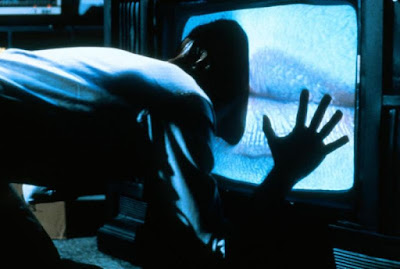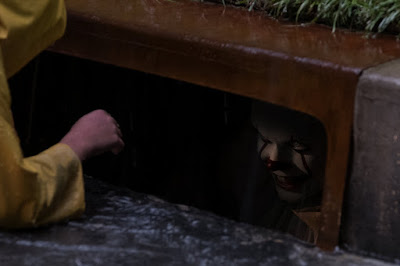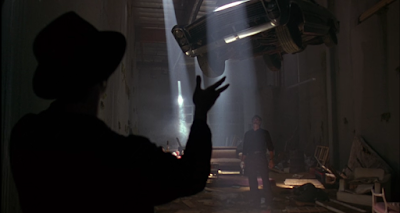Although the real world caught up with Videodrome (1983, directed by David Cronenberg) a long time ago, in the late 2000-teens, it seems especially prophetic. What is the work of Russian bots and Cambridge Analytica and Fox News but the exact same "philosophical" signal as the one behind Videodrome? The Videodrome conspiracy is a right wing authoritarian fantasy made flesh as gooey cyberpunk hallucination. The real world version is, perhaps, even scarier and more insidious, one that has already wormed its way into every corner of the world's media. One lone assassin is never going to take it down, though our real-world Videodrome continues to manufacture assassins all its own. Sometimes on a daily basis.
Sunday, October 28, 2018
New Flesh for Old
Posted by
Vulnavia Morbius
at
3:45 PM
0
comments
![]()
Labels: David Cronenberg, feminism, horror movies, October Challenge, October Challenge 2018, Science Fiction, Transgender Cinema, Videodrome
Sunday, October 21, 2018
Still More of the Night HE Came Home
When last I bothered with the Halloween movies*, with Halloween: Resurrection, I lamented that the folks at Dimension films had only themselves to blame for its failure. It committed two cardinal sins: first it killed off Laurie Strode in the prologue, a callous fuck you to anyone who might have become invested in her character over the years. Second: it was released in July. You DON'T release a movie with the word "Halloween" in the title in the middle of summer. You just don't. The makers of the new film, simply titled Halloween (2018, directed by David Gordon Green) don't make either mistake. They've ignored all of the continuity between John Carpenter's original film and their own, so Laurie Strode is still alive and Michael has not been burned alive or beheaded as the case may be, and their film has a late October release date (when it is on track to make a shitload of money).
This film represents the rubber match between Laurie and Michael: Laurie "won" the first match in Halloween H20 when she took off his head with an ax, Michael "won" Resurrection when he killed her at the mental hospital. The retcon here doesn't really bother me, given that the history of the franchise is littered with retcons. Dr. Loomis was killed at the end of Halloween II (as was Michael), but that didn't stop him from coming back in Halloween 4 and 5. Laurie Strode seems a different character in each of her subsequent appearances, too, all suggesting differing timeline branches from her teenage encounter with Michael. In H20, she was a college professor with Josh Hartnett as a son. In Resurrection, she was a mental patient. In the new film, she's a doomsday prepper, a la Sarah Connor, no longer possessed of a son, but of an estranged daughter and granddaughter. This is a series that doesn't give two fucks for internal continuity. And so it goes.
Note: what follows contains spoilers.
Posted by
Vulnavia Morbius
at
8:49 AM
0
comments
![]()
Labels: 2018, Halloween (2018), horror movies, John Carpenter, October Challenge, October Challenge 2018, slasher films
Saturday, October 20, 2018
Stephen King's America
Whenever you have a massive breakout success in the horror genre, there is usually some underlying social force at work over and above the relative quality of the film. It's not just that, say, Get Out is a crackerjack thriller. There are plenty of crackerjack thrillers that are at least as good as Get Out that never find a wide audience. But Get Out appeared in the social ferment of Black Lives Matter and a conversation about race in America that wasn't happening four years earlier. It hit a window in the zeitgeist that provided it with the exact moment to become a monster breakout success. You could probably say the same thing about the new version of Stephen King's It (2017, directed by Andrés Muschietti). As a movie, it's good enough. It's well-made. But merely being "well made" isn't enough to explain its success. Director Andrés Muschietti's last film, Mama, was "well made," but that only got it modest box office, not the gaudy success of It. As I write this, It has become the highest grossing horror movie ever made. Its success is the stuff of summer blockbusters, not autumn horror movies. You might think that this is a matter of kids who grew up in the nineties latching on to something from their childhood, but I don't think that's it, or, at least, that's not everything. Its brutal view of what childhood entails (not just in the 1980s) goes a fair way to debunking pure nostalgia as the author of the film's outsized financial success. There's more to it than that.
Posted by
Vulnavia Morbius
at
5:00 AM
0
comments
![]()
Labels: 2017, It (2017), October Challenge, October Challenge 2018, Stephen King
Friday, October 19, 2018
Life of Illusion
I was caught up in the hype when Clive Barker's short stories first started to make the rounds in the 1980s. The first three volumes of The Books of Blood made the kind of splash in the horror genre that comes around once in a generation, completely changing the rules of the genre and becoming one of the founding texts of what would become known as "splatterpunk." The cover blurb on the American paperbacks (which had completely horrible covers and not in a good way) read, "I have seen the future of horror...and it is named Clive Barker" and was attributed to Stephen King, who would know about such things you would think. Initially, it was worth the hype, too. The stories in the first three volumes were vivid and angry and genuinely original. No one had read anything like them before. Some of them were repulsive. Some of them were funny. Some of them were both at once. Some of them were decidedly queer and closeted queer me responded strongly to that. It was the one of the first examples of queer lit that I had encountered in a form that appealed to my own literary appetites. I love a good horror story. Barker often built his stories around images rather than around plots, which worked marvelously in short stories. It didn't work as well at novel length, as I discovered when his first couple of novels, The Damnation Game and Weaveworld, appeared. It worked even less well on a movie screen. The first feature film based on one of Barker's stories was Rawhead Rex, which is a masterclass in how to botch Barker's ideas. It rendered images that are terrifying and transgressive on the page ridiculous and vulgar on the screen, not helped by an atrocious monster that looks to have escaped from a Halloween rubber mask store. Watching this monster piss in the face of an Anglican vicar wasn't transgressive so much as it was just tasteless. Moreover, the film was boring, something I rediscovered when I re-watched the film earlier this month. Barker himself was a filmmaker, though, and he parlayed his literary success into a film career. His first feature film, Hellraiser, is much closer to his literary aesthetic, but it is still plagued by the literal nature of the filmed image. It's undone by dodgy special effects, particularly at the end of the film in scenes that are as ridiculous as they are confusing. Hellbound: Hellraiser 2 is arguably more effective, though Barker ceded the director's chair to Tony Randel. Barker's second feature, Night Breed, was plagued by producer interference, and although it has memorable imagery (particularly David Cronenberg's serial killer psychiatrist), it has some of the same flaws as other Barker adaptations. His third film, The Lord of Illusions from 1995 is more sure-handed. Adapting a story from the sixth volume of The Books of Blood, Barker had a bigger budget, better actors, and access to then-state of the art special effects. The result is Barker's best feature as a director. But it's not an unqualified success.
Posted by
Vulnavia Morbius
at
5:00 AM
0
comments
![]()
Labels: horror movies, October Challenge, October Challenge 2018, The Lord of Illusions
Thursday, October 18, 2018
A Dream Within A Dream
My local art house is running a series of classic (or "classic") horror movies for Halloween this year. The first in the series was Wes Craven's A Nightmare on Elm Street (1984), which plays pretty well to an audience of young people even today. Most of the audience I was with was under thirty. A large part of it was under 20. Teenagers, it seems, never get tired of seeing other teenagers massacred on screen. It was a good time at the theater, though I admit that Nightmare is not a film of which I am overly fond. But, whatever. I don't get to make the canon and it's a film whose place is firmly established.
Craven conceived of Nightmare after reading about a number of refugees from Southeast Asia who had died in the throes of nightmare from unexplained causes, and formulated the character of Freddy Kruger after the model of the song, "Dream Weaver," by Gary Wright. Craven, a magpie for ideas, incorporated a number of other influences as well, but the idea that if you die in your sleep, you die in real life is the spark behind the film's ideas. The central theme of Nightmare is the tenuous boundary between reality and dreams. At its core, it's an epistemological film shaped in the form of a slasher film.
Posted by
Vulnavia Morbius
at
6:21 AM
0
comments
![]()
Labels: A Nightmare on Elm Street (1984), horror movies, October Challenge, October Challenge 2018, slasher films
Sunday, October 07, 2018
Fearless Vampire Hunter
Blade (1998, directed by Stephen Norrington) didn't seem like a landmark film at the time of its release, but time has been kind to it. It remains a shock that this film and this character were the first foundations laid in what has become the Marvel Entertainment empire. Blade never had a comic book of his own prior to the movie. He was a supporting character from the long-forgotten Tomb of Dracula series in the 1970s. And yet was the first Marvel Comics character to become a big screen success after previous attempts--famously Howard the Duck, less famously The Punisher and Captain America--crashed and burned in spectacular fashion. But more than that. Blade ushered in both a cinematic idiom and design aesthetic that would spread like wildfire throughout cinema. The Matrix movies were the immediate inheritors of Blade's fetish-attired action look, but you can see it in the Underworld movies, too, and in the Resident Evil movies, and in countless vampire films and television shows littering the backwash in the film's resulting wake in the myth pool. Pick up any given "urban fantasy" romance novel these days and you'll see an echo of Blade's influence right there on the cover. Guaranteed.
Posted by
Vulnavia Morbius
at
5:51 PM
0
comments
![]()
Labels: Blade (1998), horror movies, Marvel Comics, October Challenge, October Challenge 2018, Superheroes
Saturday, October 06, 2018
What Big Teeth You Have
Although it came during the cycle of werewolf movies of the early 1980s, Neil Jordan's The Company of Wolves (1984) doesn't have much in common with The Howling or An American Werewolf in London and their imitators. Apart from a taste for gory transformation effects, The Company of Wolves comes from the tradition of arty European horror movies from a decade or so earlier, indeed going back to the likes of Cocteau's Beauty and the Beast or Jaromil Jires's Valerie and Her Week of Wonders. Like these films, The Company of Wolves reinterprets the Gothic through a modernist lens, influenced as much by surrealism and by the various European New Wave movements as by the then-contemporary norms of the horror movie. Its director claims that it's not a horror movie at all, but there is a whiff of self-interested deflection in that pronouncement. And besides, Jordan has made several other horror movies of a similar bent, so it's not like a horror movie is out of character for him. But in some ways, he has a point. There is certainly an otherness to The Company of Wolves that sets it apart from its contemporaries.
Posted by
Vulnavia Morbius
at
7:05 AM
0
comments
![]()
Labels: British film, feminism, horror movies, October Challenge, October Challenge 2018, The Company of Wolves
Wednesday, October 03, 2018
Woof!
I have to give Wolfcop (2014, directed by Lowell Dean) some credit: it showed me something I've never before seen in a movie. During its first transformation scene, we start not with the hand that's turning into a paw, nor with the face that is sprouting hair or distending into a snout. No. That is for "lesser" werewolf movies. We start, instead, with our titular hero's penis, as he's pissing. It expands and becomes harrier as it transforms into a wolf cock. I admit that I laughed my ass off at this because there's still a ten year old lurking somewhere in the back of my brain. This scene tells you most of what you need to know about the artistic aspirations of this movie.
Posted by
Vulnavia Morbius
at
7:16 PM
0
comments
![]()
Labels: horror movies, October Challenge, October Challenge 2018, Wolfcop



















